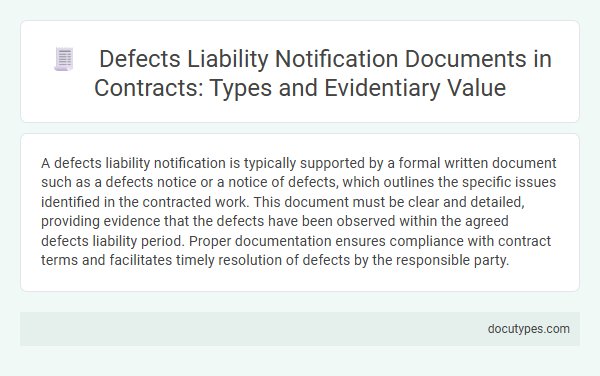A defects liability notification is typically supported by a formal written document such as a defects notice or a notice of defects, which outlines the specific issues identified in the contracted work. This document must be clear and detailed, providing evidence that the defects have been observed within the agreed defects liability period. Proper documentation ensures compliance with contract terms and facilitates timely resolution of defects by the responsible party.
Introduction to Defects Liability in Contracts
Defects liability in contracts refers to the period after project completion during which the contractor is responsible for rectifying any defects. This ensures the quality and durability of the work performed.
The primary document serving as evidence for a defects liability notification is the written notice issued by the client or their representative. Your formal notification must clearly detail the defects observed to initiate the contractor's responsibility for repairs.
Understanding Defects Liability Notification Documents
Understanding the documents that serve as evidence for a defects liability notification is crucial in contract law. These documents confirm the identification and reporting of defects within the agreed liability period.
- Defects Liability Notice - A formal written notification submitted by the client or contractor detailing identified defects.
- Inspection Report - An official document prepared after a site inspection highlighting the specific defects observed.
- Correspondence Records - Communication exchanges such as emails or letters that verify the notification of defects to the responsible party.
Types of Defects Liability Notification Documents
Defects Liability Notification is typically documented through formal letters, inspection reports, or email correspondences that detail the identified defects. Inspection reports provide structured evidence with specifics on the nature, location, and severity of the defects. Formal letters serve as official records exchanged between contractors and clients to acknowledge and address defects within the liability period.
Key Elements to Include in Notification Forms
| Type of Document | Defects Liability Notification Form |
|---|---|
| Purpose | Serves as formal evidence for reporting defects in construction or contracted works within the defects liability period |
| Key Elements to Include |
|
| Legal Significance | Acts as a binding record within the contract's defects liability period, establishing your rights to request remedy or repairs |
Legal Requirements for Notification Documents
Notification documents for defects liability must meet specific legal requirements to serve as valid evidence. Proper documentation ensures enforceability of claims related to construction defects under contract law.
- Written Format - The defects liability notification must be provided in a written document to comply with contractual and legal standards.
- Clear Identification - The document must clearly identify the defective work or materials to establish the scope of the claim.
- Timely Submission - Notification must be submitted within the timeframe specified in the contract to preserve the claimant's rights.
A document fulfilling these criteria acts as admissible evidence in disputes over defects liability claims.
Evidentiary Value of Defects Liability Notifications
What type of document serves as evidence for a defects liability notification? A defects liability notification must be a formal written document that clearly identifies the defects and requests remedial action. The evidentiary value of such notifications lies in their ability to provide a timestamped, verifiable record essential for contract enforcement and dispute resolution.
Formal vs. Informal Notification Methods
A defects liability notification typically requires a formal document to serve as valid evidence. This document must clearly outline the identified defects and comply with the contract's notification requirements.
Formal notification methods often include written letters, emails with read receipts, or certified mail to ensure delivery confirmation. Informal methods such as verbal notifications or casual messages generally lack legal standing in contract disputes. Courts and contract administrators prioritize documented evidence that adheres to specified procedures for defects liability claims.
Best Practices for Drafting Defects Notification Documents
Defects liability notifications require precise documentation to ensure clear evidence of reported issues. Properly drafted documents protect the rights and obligations of all parties involved in a contract.
- Written Defects Notification - A formal, written document specifying the defects with detailed descriptions serves as primary evidence for liability claims.
- Photographic Evidence - Including dated, clear photographs of the defects strengthens the notification and supports verifiable proof.
- Reference to Contract Terms - Citing exact clauses related to defects liability ensures the notification aligns with contractual obligations and timelines.
Common Pitfalls in Issuing Defects Liability Notifications
The primary document serving as evidence for a defects liability notification is the formal written notice submitted to the contractor or responsible party. Common pitfalls in issuing these notifications include vague descriptions of defects, missing deadlines, and failure to comply with contract-specific requirements. Ensuring your notification is precise, timely, and aligned with contract terms is crucial to enforce liability effectively.
What Type of Document Serves as Evidence for a Defects Liability Notification? Infographic

